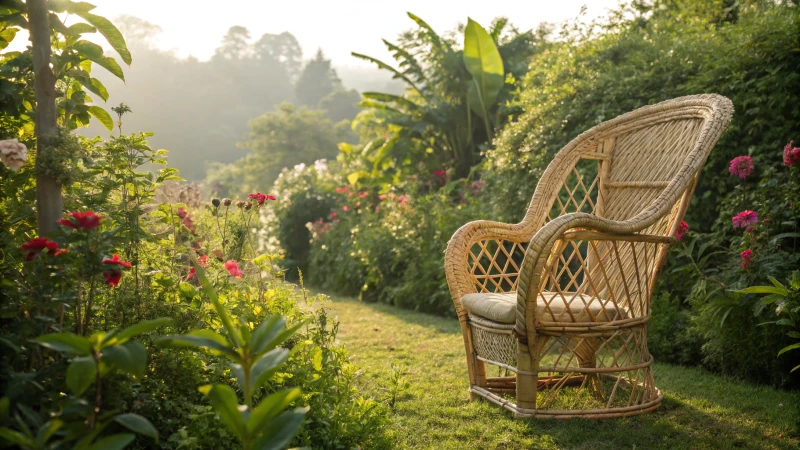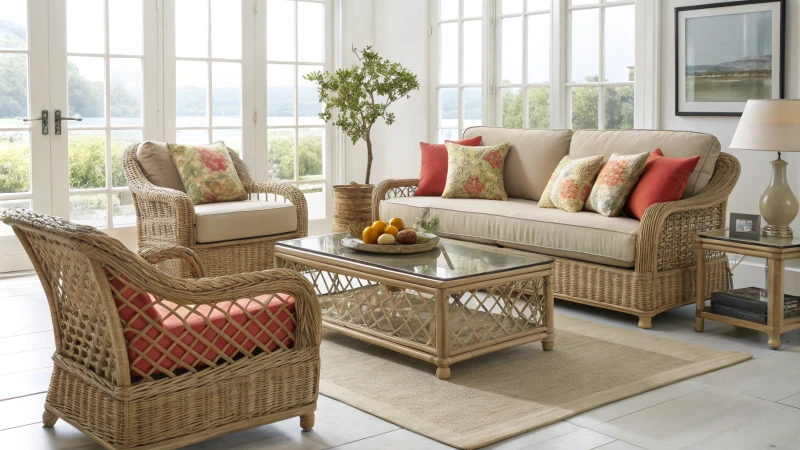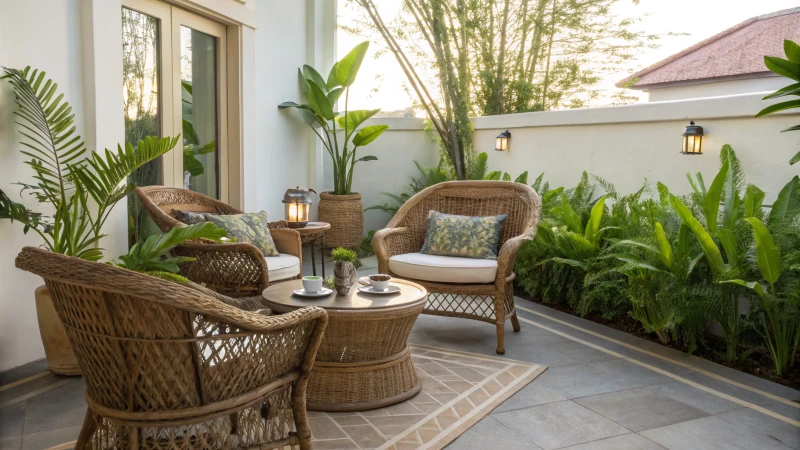
Interested in rattan? Many people share this curiosity! I recall discovering this fascinating material for the first time. Its flexibility impressed me. However, understanding its type was confusing.
Rattan is a type of vine. Many people confuse it with wood or grass because of how it looks. It feels like wood, but it is actually a climbing palm. Its structure is more like grass. People often mistake rattan’s true nature. This blog explores its special features. It discusses how rattan is used in furniture design. It also offers important care tips. Every buyer should know these tips.
Let’s clarify this matter. Rattan is not wood or grass. It is actually a climbing palm. This is why people often find it confusing. I have always been fascinated by rattan’s unique qualities. It beautifully combines strength with flexibility. I value design and craftsmanship. Understanding rattan’s true nature was important for me. This was especially true when I searched for materials for projects.
Rattan is a type of climbing palm, not wood.True
Rattan is classified as a climbing palm, distinguishing it from wood and grass.
Rattan shares more characteristics with wood than grass.False
Despite its appearance, rattan has more biological similarities to grass than to wood.
What Makes Rattan Such a Special Material?
I explore the remarkable qualities of rattan. This material is a favorite for furniture enthusiasts. Decor lovers also adore it.
Rattan is loved for its strong, bendable nature, beautiful look and eco-friendly qualities. People use it for furniture and decorative items. It suits those who care about style and the environment.

Durability and Longevity
Rattan has much to offer and I really admire this unique material. Learning more about rattan deepens my appreciation for its strength, flexibility, beauty and eco-friendliness. These traits contribute to its reputation as an exceptional pick for crafting beautiful furniture and decorative items.
Rattan’s durability truly impresses me. I bought a set of outdoor rattan furniture and it resisted the elements very well. It has survived many storms and sunny days with some care, without losing charm. Rattan naturally fights wear and tear. It is a game changer for those who value long-lasting home decor.
For example, outdoor rattan furniture often features a synthetic coating that enhances its lifespan against moisture and UV rays. Check out the comparison of rattan’s durability against other materials here1.
Flexibility and Versatility
Rattan fascinates with its flexibility. Artisans bend and twist rattan into complex shapes, impossible with stiffer materials. This allows for creativity in furniture design. The versatility of rattan extends beyond furniture; it’s also used in light fixtures and decorative items, providing a natural aesthetic to various applications. Explore creative uses of rattan in design here2.
Aesthetic Appeal
People love rattan’s aesthetic appeal. Its warm, natural look transforms spaces into cozy havens. Natural texture mixes seamlessly with bohemian or modern styles. Rattan adds inviting depth to homes.
Customization is even better! Painted or stained rattan pieces match different color schemes, providing a unique touch to furniture pieces. Discover various finishes and how they affect rattan’s appearance here3.
Sustainability
Sustainability matters today and rattan excels here. It’s a renewable resource that grows quickly, harvested without harming the environment. This characteristic makes it a favored choice among designers who prioritize sustainable practices.
Rattan also contributes to biodiversity as it thrives in forests that support various wildlife species. Learn more about the sustainability benefits of using rattan in manufacturing here4.
Conclusion
Rattan’s unique traits make it a standout in design. Durability, flexibility, beauty and sustainability explain its popularity among designers like Isabella who seek quality and ethical sourcing.
Rattan is highly resistant to wear and tear.True
Rattan's natural durability allows it to withstand various environmental conditions, making it ideal for furniture.
Rattan cannot be bent or twisted without breaking.False
Contrary to this claim, rattan is known for its remarkable flexibility, enabling intricate designs.
How Does Rattan Compare to Bamboo?
Have you ever stood in a room filled with sunlight, admiring the textures and colors of your furniture? Maybe you wonder about the materials that join everything together. Let’s explore the unique worlds of rattan and bamboo. Discover what makes these materials special.
Rattan bends easily and weighs little. It is perfect for complex designs. Bamboo is strong and firm. It works well for building structures. Choose between them based on what looks good to you. Also, consider how much you care about the environment and how much you want to spend.

Physical Properties of Rattan vs Bamboo
When comparing rattan and bamboo, the first aspect to consider is their physical properties. Rattan is a climbing palm that has a flexible, robust structure, making it suitable for intricate designs in furniture and crafts. In contrast, bamboo is a grass that offers a stronger and stiffer material. This difference affects how each material is used in various applications.
- Rattan: Flexible, lightweight, ideal for weaving and intricate designs.
- Bamboo: Strong, rigid, better suited for structural applications.
Both materials have unique strengths that cater to different design needs. For instance, if you want to create elegantly woven furniture, explore the versatility of rattan5. However, for more robust applications like flooring or load-bearing furniture, consider the strength of bamboo6.
Aesthetic Appeal
The aesthetic qualities of rattan and bamboo also differ significantly. Rattan often boasts a warm, natural look that fits seamlessly into various interior styles, from rustic to modern. Bamboo, while still appealing, has a more contemporary feel with its smooth finish and uniform texture.
| Material | Aesthetic Qualities | Common Uses |
|---|---|---|
| Rattan | Warm, natural look | Furniture, decor items |
| Bamboo | Smooth, contemporary | Flooring, structural applications |
For those looking to enhance the visual appeal of their projects, understand the aesthetic benefits7 of each material before making a choice.
Sustainability Considerations
Sustainability is a significant factor in material selection. Rattan is often considered more sustainable because it can be harvested without cutting down the entire plant, allowing it to regrow. Bamboo grows rapidly and can be harvested every few years; however, the environmental impact depends on harvesting practices.
- Rattan: Harvested sustainably; regrows after cutting.
- Bamboo: Fast-growing; can be harvested frequently without damaging ecosystems.
Choosing sustainable materials is crucial for environmentally conscious buyers. To learn more about eco-friendly practices in material sourcing, check out these sustainability insights8.
Cost Analysis
Cost is always a consideration when selecting materials. Generally, rattan tends to be pricier due to its labor-intensive harvesting and crafting process. Bamboo is often more affordable because of its abundance and rapid growth cycle.
| Material | Average Cost per Unit (approx) | Cost Considerations |
|---|---|---|
| Rattan | Higher due to craftsmanship | Labor-intensive; limited supply in some areas |
| Bamboo | Lower due to rapid growth | Widely available; cheaper sourcing options |
Understanding your budget can help you decide which material aligns with your project goals. For detailed cost comparisons between these materials, explore pricing trends here9.
Conclusion
While the sub-heading does not warrant a conclusion,
k understanding these differences can significantly impact your decision-making process when choosing between rattan and bamboo for your specific needs.
Rattan is more flexible than bamboo.True
Rattan's flexible structure allows for intricate designs, unlike bamboo's rigidity.
Bamboo is more expensive than rattan.False
Bamboo is generally more affordable due to its rapid growth and availability compared to labor-intensive rattan.
What Are the Best Uses for Rattan in Furniture Making?
Rattan has won my heart as a material for creating furniture. But why is it so special? I invite you to discover its best uses with me. Rattan probably changes your space with its unique charm.
Rattan stands out in furniture creation for seating and decorative accents. It offers eco-friendly choices and customization. This material has durability and aesthetic charm. Its sustainable nature suits many uses. Rattan changes any space into something very special.

Versatile Seating Options
Rattan is an incredibly flexible material. I often use it for building furniture. Its mix of strength and flexibility really allows for creative uses. It becomes cozy seating, stylish accents or eco-friendly options. When I see rattan in a home, I think of stories it would probably tell.
Rattan reminds me of delightful summer evenings in my favorite chair, with a warm breeze around. Its flexibility and strength suit various seating options. People use it for chic dining chairs or comfy lounge chairs. It naturally resists moisture and UV rays, making it perfect for outdoor furniture.
I created my own small outdoor oasis with rattan furniture. I added vibrant, weather-resistant cushions. Every guest commented on how inviting this space felt. It became a cherished gathering spot. You can explore more about creating the perfect outdoor setup10.
Stylish Decorative Accents
Rattan includes more than just functional furniture. It really shines in decorative elements. A simple side table can uplift a room. I made a stunning light fixture from rattan. It changed the mood of my living room when lit. The intricate patterns cast mesmerizing shadows, sparking conversation at every dinner party. Check out our guide on lighting design trends11.
Eco-Friendly Furniture Making
Sustainability matters more to me every day. I appreciate rattan’s eco-friendly quality. Grown from fast-growing palms, it’s a renewable resource that needs little processing.
Using rattan elevates my designs while supporting sustainable living. Each piece I create with rattan supports eco-conscious practices. You might want to explore the advantages of sustainable materials12. This is an exciting path to dig into.
Unique Customization Possibilities
Rattan offers thrilling customization possibilities. I enjoyed experimenting with its shape and weave, crafting bespoke pieces reflecting individual styles.
High-end furniture brands often choose rattan for tailored solutions. Explore custom furniture design to unleash your unique vision and learn more about custom furniture design13 by exploring further.
Rattan is ideal for outdoor furniture due to its moisture resistance.True
Rattan's natural properties make it resistant to moisture and UV rays, perfect for outdoor seating solutions.
Rattan furniture is not eco-friendly due to high processing needs.False
Contrary to this claim, rattan is eco-friendly as it requires minimal processing and is a renewable resource.
How Can You Keep Your Rattan Furniture in Top Shape?
Are you ready to learn the secrets to keeping your rattan furniture looking fresh? Let’s explore some simple tips that protect your investment. These tips reveal how to keep the natural beauty of your furniture. Keep your rattan furniture looking vibrant.
Dust rattan furniture often to keep it in great condition. Clean with mild soap to remove dirt and grime. Protect it from moisture and harmful UV rays. Dry it completely after cleaning. This really helps to keep its natural beauty. Drying very thoroughly extends its life.

Understanding Rattan Furniture Care
Maintaining rattan furniture is essential to ensure its longevity and aesthetic appeal. Rattan, being a natural material, requires specific care practices to keep it looking great. Here are some detailed tips on how to properly maintain your rattan furniture:
-
Regular Dusting
Dusting my rattan furniture with a soft cloth or feather duster is a weekly habit. Dust builds up fast and this simple task stops dirt from causing damage. -
Cleaning with Mild Soap
When my furniture looks dull, I mix a gentle soap with warm water. I use a soft sponge to carefully clean every spot and avoid harsh chemicals that might harm the finish. -
Drying Properly
After cleaning, drying my rattan thoroughly is essential. I use a dry cloth to remove extra moisture and let it air dry. I keep it out of direct sunlight to prevent damage. -
Using Protective Coatings
Sometimes, I apply a protective coat or sealant to my rattan. It acts like a cozy blanket, keeping away stains and saving its natural fibers. Always make sure it’s safe for natural materials. -
Storing Indoors During Bad Weather
Bad weather is a threat to outdoor rattan furniture. During storms, I bring them inside to protect from rain and strong sunlight. -
Avoiding Excessive Heat and Moisture
My rattan stays away from heat sources like radiators and fireplaces. It should not be in high humidity areas, which can cause warping or mold – not pleasant!
Specific Techniques for Indoor vs. Outdoor Rattan Furniture
| Feature | Indoor Care Tips | Outdoor Care Tips |
|---|---|---|
| Cleaning Frequency | Monthly deep clean | Bi-weekly cleaning due to exposure |
| Protective Measures | Use coasters and placemats | Apply UV-resistant spray regularly |
| Storage Recommendations | Can be left in place | Store in a covered area during off-season |
Recommended Products for Rattan Maintenance
- Rattan Cleaner: A mild cleaner made especially for rattan, protecting its finish.
- Sealer: A sealer that keeps moisture and stains away.
- Conditioner: A natural oil conditioner to keep flexibility and stop cracking.
By following these maintenance steps keeps your rattan furniture as stunning as the first day you got it. For more detailed advice on caring for your precious pieces, check out advanced cleaning techniques14 or best protective coatings. Let’s protect that natural beauty together!
Rattan furniture requires weekly dusting for proper maintenance.True
Regular dusting helps prevent dirt buildup, which can lead to wear over time.
Harsh chemicals are safe for cleaning rattan furniture.False
Using harsh chemicals can damage the finish of rattan furniture, so mild soap is recommended.
Conclusion
Rattan is a climbing palm known for its flexibility and durability, making it popular in furniture design. This post explores its characteristics, care tips, and sustainability.
-
Explore this link to gain insights into how rattan compares with other materials regarding durability and flexibility, enhancing your understanding of material choices. ↩
-
Click here to find innovative ways rattan can be utilized in design projects, expanding your creative possibilities with this versatile material. ↩
-
Understanding the finishes available for rattan will help you choose the right aesthetic for your projects; check this resource for inspiration. ↩
-
Discover why choosing rattan is beneficial for sustainability in your projects by following this link. ↩
-
Explore this link to gain insights on the unique properties of rattan and bamboo for your projects. ↩
-
This resource provides valuable information on the aesthetic appeal of both materials for home decor. ↩
-
Learn about sustainable practices related to rattan and bamboo sourcing through this informative link. ↩
-
Get insights on cost comparisons between rattan and bamboo for budgeting your project. ↩
-
Check this link for a comprehensive understanding of using rattan and bamboo in furniture design. ↩
-
Clicking here will provide you with insights into creating a comfortable outdoor space using rattan furniture. ↩
-
Explore lighting design trends featuring rattan to elevate your decor. ↩
-
Learn about sustainable materials and their benefits for eco-friendly furniture making. ↩
-
Discover how to achieve unique custom furniture designs using rattan. ↩
-
Explore expert insights on maintaining your rattan furniture to enhance its lifespan and aesthetic appeal. ↩

